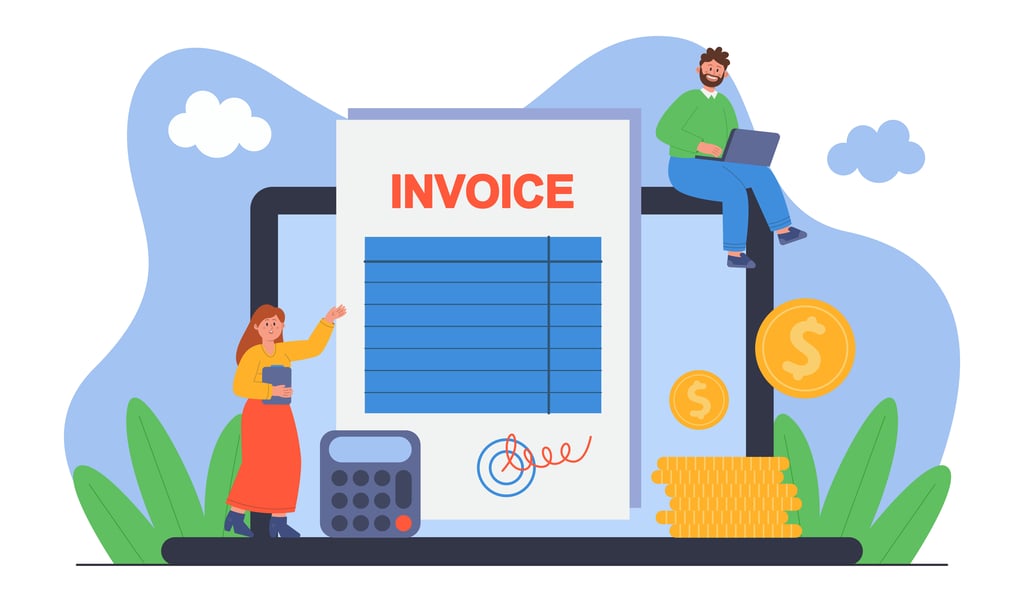Invoice Automation: Streamlining the Invoice Management Process

When it comes to managing invoices, time is money – quite literally. The importance of streamlining your invoice management process cannot be overstated. Not only does it save you valuable time and resources, but it also eliminates errors, improves cash flow management, and enhances vendor relationships.
The Importance of Efficient Invoice Management
In the world of business, every penny counts. Efficient invoice management is not just about staying organized; it’s a crucial element for financial success. When invoices are processed manually, there is an increased risk of errors and delays, which can lead to late payments or missed opportunities.
By implementing efficient invoice management practices, businesses can improve cash flow by ensuring timely payment processing. This allows organizations to maintain healthy vendor relationships and negotiate better terms with suppliers. Additionally, streamlined invoice management reduces the likelihood of duplicate payments or overpayments – saving valuable resources that could be invested elsewhere.
Efficiency in invoice management also enables businesses to gain better visibility into their spending patterns. By tracking and analyzing invoicing data, organizations can identify areas where costs can be reduced or optimized. This insight empowers strategic decision-making and helps drive overall profitability.
Furthermore, efficient invoice management improves internal processes and reduces administrative burden on finance teams. Automation eliminates manual data entry tasks, freeing up time for employees to focus on more value-added activities.
Efficient invoice management is not just a matter of convenience – it directly impacts the bottom line of businesses. It enhances financial control, strengthens supplier relationships, optimizes resource allocation and promotes growth in today’s competitive landscape.
What is Invoice Automation?
Invoice automation is a technology-driven solution that simplifies and streamlines the entire invoice management process. It eliminates the need for manual data entry, paper-based documents, and repetitive tasks associated with handling invoices. Instead of relying on labor-intensive processes, businesses can leverage automation tools to handle invoice creation, routing, approval workflows, and payment processing.
With invoice automation software in place, businesses can reduce errors caused by manual data entry and improve overall accuracy. The system automatically captures relevant data from invoices such as vendor information, purchase order detailspurchase order detailstotal amounts. This eliminates the need for employees to manually enter this information into their accounting systems.
In addition to improving accuracy and efficiency, invoice automation also provides real-time visibility into the status of invoices. Businesses can track each stage of the invoicing process – from submission to approval to payment – ensuring transparency and accountability.
Furthermore, invoice automation allows for faster processing times. Automated workflows ensure that invoices are routed promptly to approvers based on predefined rules or thresholds. This reduces bottlenecks in the approval process that often occur with manual methods.
Another key benefit of implementing invoice automation is cost savings. By eliminating paper-based processes and reducing human intervention in managing invoices, businesses can significantly reduce administrative costs associated with traditional methods of invoicing.
Moreover, invoice automation enhances compliance by enforcing company policies related to spending limits or approvals before payments are made. It also improves supplier relationships as automated systems provide better visibility into payables timelines.
Additionally, it increases productivity by freeing up time spent on mundane administrative tasks so employees can focus on more strategic activities.
Finally, invoice automation helps create an auditable trail of all financial transactions related to invoicing which proves valuable during audits or regulatory reviews
Benefits of Implementing Invoice Automation
Implementing invoice automation can bring numerous benefits to businesses of all sizes. One major advantage is the significant reduction in manual data entry and paperwork. With automation, invoices are automatically captured, validated, and entered into the system, eliminating the need for manual processing.
Another benefit is improved accuracy and reduced errors. Manual data entry is prone to mistakes, such as typos or incorrect calculations. Invoice automation eliminates these errors by automatically populating information from the invoice into relevant fields, ensuring accurate data.
Invoice automation also enhances efficiency by streamlining workflows and reducing processing time. Automated systems can route invoices for approval electronically, allowing for faster review and decision-making. This not only speeds up payment cycles but also improves supplier relationships by ensuring timely payments.
Additionally, implementing invoice automation provides better visibility and control over financial processes. Real-time tracking enables businesses to monitor the status of invoices at any given moment. It allows for greater transparency while facilitating audit trails to ensure compliance with regulations.
Furthermore, automated invoice management helps businesses optimize cash flow management by providing insights into spending patterns and payment terms with suppliers. The ability to track expenses more effectively enables organizations to identify cost-saving opportunities and negotiate favorable terms with vendors.
Implementing invoice automation contributes to sustainability efforts by reducing paper usage in administrative tasks. By digitizing documents and moving towards a paperless environment, companies can reduce their environmental footprint while enhancing operational efficiency.
How to Automate Your Invoice Management Process
Implementing invoice automation can significantly streamline your invoice management process, saving time and increasing efficiency. Here are some steps to help you automate your invoice management process effectively:
1. Evaluate your current process: Before implementing any automation solution, it’s crucial to assess your existing invoice management process. Identify bottlenecks, manual tasks that consume excessive time and resources, and areas prone to human error.
2. Choose the right software: Selecting the appropriate software is key to successful automation. Look for a solution that aligns with your business needs and integrates smoothly with your existing systems like accounting software or ERP.
3. Establish workflow rules: Create clear guidelines for routing invoices through different departments or individuals involved in the approval process. Define roles and responsibilities to ensure accountability at each stage of the workflow.
4. Digitize incoming invoices: To automate efficiently, start by digitizing all incoming invoices either through scanning physical documents or receiving electronic invoices directly into the system.
5. Implement Optical Character Recognition (OCR): OCR technology allows for automated data extraction from invoices, reducing manual data entry errors while populating relevant fields such as vendor name, date, amount due, etc.
6. Set up automatic matching: Configure rules within the system so that when an invoice is received, it can be automatically matched against purchase orders or contracts based on predefined criteria.
7. Enable electronic approvals: Implement electronic approval workflows where approvers receive notifications via email or a centralized dashboard allowing them to review and approve invoices digitally without physical paperwork delays.
8. Streamline payment processing: Once approved electronically, integrate automated payment processes like Electronic Funds Transfer (EFT) or Automated Clearing House (ACH) payments directly from the invoicing system itself.
By following these steps carefully tailored to fit your organization’s specific requirements, you can successfully automate your invoice management process and enjoy increased productivity and accuracy in handling financial transactions.
Common Pitfalls and How to Avoid Them
Implementing invoice automation can greatly streamline your invoice management process, but it is not without its challenges. Here are some common pitfalls to watch out for and practical tips on how to avoid them.
One of the most significant pitfalls of implementing invoice automation is a lack of proper planning and preparation. Before diving into automation, take the time to assess your current processes, identify pain points, and set clear goals for what you want to achieve with automation.
Another pitfall is inadequate communication and training. It’s crucial to involve all relevant stakeholders from the beginning and ensure they understand the benefits of automation. Provide comprehensive training sessions or workshops so that everyone knows how to use the new system effectively.
Integration issues can also arise when implementing invoice automation. Make sure that your chosen software integrates smoothly with your existing systems such as accounting software or enterprise resource planning (ERP) systems. Test thoroughly before going live to avoid any compatibility problems.
Data accuracy is another potential pitfall in automated invoicing. Ensure that all data entered into the system is accurate from the start by setting up validation rules, double-checking entries, or using optical character recognition (OCR) technology for data extraction.
Don’t overlook security concerns when automating your invoice management process. Protect sensitive financial information by choosing a secure software provider, implementing access controls, regularly updating passwords, and conducting regular audits.
By being aware of these common pitfalls and taking proactive steps to mitigate them, you can ensure a successful implementation of invoice automation in your organization.
Future of Invoice Automation and its Impact on Businesses
The future of invoice automation looks promising, as more businesses are recognizing the numerous benefits it offers. With advancements in technology and the increasing availability of sophisticated software solutions, invoice automation is set to revolutionize the way businesses manage their finances.
One key impact of invoice automation is increased efficiency. By automating manual tasks such as data entry and approval processes, businesses can save valuable time and resources. This allows employees to focus on more strategic activities that add value to the organization.
Additionally, invoice automation improves accuracy by reducing human errors often associated with manual data entry. Automated systems can perform validations to ensure that invoices meet specific criteria before they are processed. This not only helps prevent mistakes but also minimizes the risk of fraudulent activity.
Another significant impact is improved cash flow management. Invoice automation enables faster processing times, which means suppliers get paid quicker. This can lead to stronger supplier relationships and potentially better pricing terms for businesses.
Furthermore, with real-time visibility into financial data provided by automated systems, businesses gain greater control over their financial operations. They can access critical information instantly, enabling them to make informed decisions based on accurate insights.
The future of invoice automation holds immense potential for businesses across various industries. As technology continues to advance and organizations embrace digital transformation initiatives, we can expect further innovation in this field. Embracing invoice automation will undoubtedly bring about increased efficiency, accuracy, improved cash flow management,and enhanced decision-making capabilities for businesses seeking a competitive edge in today’s fast-paced marketplace.
Conclusion
The traditional manual invoice management processes are time-consuming, prone to errors, and can hinder productivity. However, with the advent of invoice automation technology, businesses now have a powerful tool at their disposal to streamline their invoice management process.
Invoice automation simplifies and accelerates the entire invoicing cycle, from receiving invoices to making payments. By eliminating manual data entry and automating repetitive tasks, organizations can significantly reduce processing times and improve accuracy. This not only saves valuable time but also frees up resources that can be redirected towards more strategic initiatives.
The benefits of implementing invoice automation are vast. It improves efficiency by reducing human error, eliminates paper-based inefficiencies, enhances visibility into the entire invoicing process, facilitates better cash flow management through faster approvals and payment processing, strengthens supplier relationships by ensuring timely payments while minimizing disputes or delays.
While implementing invoice automation offers numerous advantages for businesses across industries and sizes alike – it’s essential to avoid common pitfalls along the way such as poor planning or inadequate training/support for employees during implementation.
Looking ahead into the future of procurement processes like invoicing – we can expect further advancements in technology-driven solutions such as artificial intelligence (AI) capabilities which could revolutionize how invoices are managed even further!

